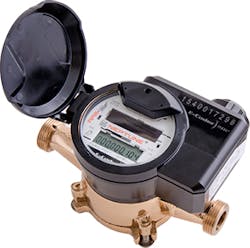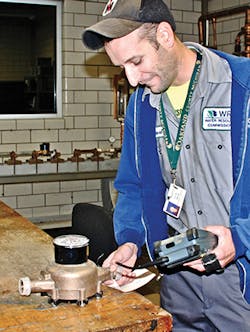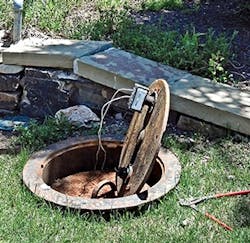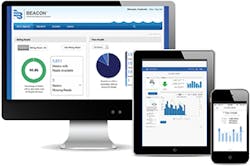Prior to the introduction of automatic meter reading (AMR, also known as automated meter reading), water utilities had to do everything by hand. With AMR came the opportunity to utilize technology to reduce costs and improve productivity. Then came Advanced Metering Infrastructure (AMI), in which technology provided advances that water utility executives could have hardly even dreamed of a decade earlier.
So which makes more sense for a water utility—AMR or AMI? In sum, AMR is less expensive, but offers less features and benefits. AMI is more expensive, but offers almost the ultimate in features and benefits. For some utilities, particularly smaller ones with limited budgets, AMR may be all that is needed. For larger utilities, AMI may be the way to go.
However, it seems, even for utilities that initially opt for AMR, there may be value in selecting a vendor that also provides AMI, which can allow for a hybrid system from the start, or at very least allow a transition from AMR to AMI to take place smoothly in the future, when AMI may make more sense for the utility.
And, in what may surprise some, there are now some technologies that can take AMI to an even higher level.
The Case for AMR
“Meter reading is a necessary, but oftentimes tedious, function of a utility company,” says Kali Gerhardt, marketing manager of global marketing for Kamstrup Water Metering. “Automating this important task helps utilities make the most of their limited time and resources. We see more and more how utilities have to do more with less.
AMR offers several time and resource-saving benefits.”
One of Kamstrup’s customers, North City, IL, was able to reduce its reading time from 30 hours a month to just three and a half hours. Prior to AMR, the city was paying a subcontractor to do the readings, but is now able to do the readings itself.
“It is also safer to read a meter from a vehicle, which AMR allows, than to have to get out and read it manually,” says Gerhardt. “Keeping workers safe is the highest priority of all utilities, for their well-being as well as the costs associated with an injured employee.”
AMR is also cost-effective. Some of the smallest utilities have been able to reap the benefits of AMR at a cost lower than AMI technology, according to Gerhardt.
AMR does require “truck rolls,” though, as it is a drive-by system. “However, some utilities will multi-task their meter reading, meaning that, while they are out for maintenance work or other services, they will also have remote reading tools on-board and can read meters during that time,” she says.
One water utility that is satisfied with its AMR technology is Davie County (NC) Public Utilities, which has a water system with 11,000 service connections in a 400-square-mile service area that is divided into 30 rural reading routes. The manual process of meter reading used to take so long (50 days) that the utility district could only bill customers once every two months. In addition, misreads were common, since it was a manual/visual process.
“Davie County and its townships are growing, and we knew we wouldn’t be able to keep up, considering how long it took us to collect readings over such a wide service area,” says Johnny Lambert, director of Davie County Public Utilities. “As a result, we began researching AMR, and, since we have a bi-monthly billing cycle, we were especially interested in a solution that stored meter reads throughout the entire billing period.”
The utility ended up selecting an AMR system called HotRod, offered by Mueller Systems. Now, a meter reader can read 3,000 meters in two days with virtually 100% accuracy. Given the size of the utility’s service area, it elected to install the new meters over a period of years. “This eased the pressure of cost all at once,” says Lambert.
Besides the increased productivity and accuracy, environmental issues and safety have improved. “We have been able to reduce the number of meter reading vehicles, which reduces CO2 emissions,” he says. “We have also reduced safety hazard exposures for employees and helped reduce accidents.”
Does the utility eventually plan to migrate to AMI? Not according to Lambert, because there is no reason to do so. “We are a rural county, and AMR will continue to fit our needs for years to come,” he says.
The Case for AMI
According to Chris King, global chief regulatory officer for Siemens Smart Grid, one key difference between AMR and AMI is that, with AMI, you can get reads on meters in real time, meaning that you can get detailed consumption every day, or even every hour, rather than once a month. One benefit of this is identifying possible leaks. “For example, if hourly information is showing that water use in continuous, it likely means that there is a leak, and the utility can reach out to the customer to alert them to the possible problem,” he says.
AMI also allows the water utility to locate system leaks, not just individual customer location leaks. This can potentially avoid a large-scale failure. “That is, if you can locate a leak early and address the problem, this can prevent a pipe from bursting later on, when the crack turns into a broken pipe,” says King.
One potential downside of AMI is that it costs more to implement than AMR. However, with features such as being able to prevent major pipe breaks, AMI systems can often pay for themselves rather quickly. “In addition, the majority of the cost of AMI is related to upgrading the meters themselves, including the electronic modules and communications equipment,” says King. “However, you also have to do this [with] AMR. With AMI, though, you do have to implement the communications network, but when you divide the cost of the network over each of the meters, the ‘per node’ cost is likely to be a small amount.”
In terms of keys to success in implementing AMI, it is important to decide in advance what applications will be implemented utilizing the data, such as providing information feedback to consumers on a website they can access, which has been shown to reduce water usage by 10% or more. “This is particularly important in states
like California, where the drought is such a serious problem,”
says King.
The E-CoderR900i interleaves mobile and fixed network messages to facilitate migration.
The Case for Hybrid AMR/AMI
As Joe Ball, director of solutions marketing, North American Water, for Itron sees it, AMR and AMI each have a place in a water utility, depending on what the utility is trying to improve.
“If you do select AMR, it is important to select a system that has a good migration path to get you to AMI when you need it,” he says. “Itron offers a seamless way for a utility to migrate from one to another.”
What you get with AMR and AMI is core meter-reading and meter-to-cash functionality, which provides the ability to get data from the meter into your billing system. “With AMI, though, you get granularity of data, which provides additional value with that data from an analytics tool beyond just the meter reading and billing that both AMR and AMI offer.”
If you think AMR is initially the way to go, Ball would recommend that you also consider AMI before making that decision, especially looking at the granularity of data that you can pull from an AMI system, so that you can potentially utilize that network technology sooner than later. “For example, if you opt for AMI, instead of starting out by collecting hourly data, you can start out collecting daily data,” he says. “Then you can move to more granular data in the future.”
An AMI network also offers the potential to go beyond metering, putting additional sensors into the network, such as distribution leak sensors, some remote shut-offs, and some pressure or water quality sensors.
According to Ball, some of Itron’s rural customers, which don’t need AMI for their whole network, utilize a hybrid system. “They use AMR for the low-density mobile rural routes, and then an AMI network for the denser areas,” he says. One of the features of Itron’s offerings is the ability to run that hybrid architecture, plus a smooth migration path from AMR to AMI.
Regardless of whether your choice is AMR or AMI, the most important key to success, according to Ball, is to work with your vendor and service team to identify the goals of the project, and then put in place a good definition phase (defining the system, and defining the processes that you need to address while deploying the system) in order to make sure the system will solve the problems that you want solved. “It is also important to do system testing and system acceptance at each phase,” he says.
Another vendor that offers both AMR and AMI is Sensus. “While we are a leader in North America in deployed AMI systems, we also do a tremendous amount of work in the AMR space,” says Dan Pinney, global water marketing director at Sensus.
Everything Sensus does in the water area focuses on one or both of two goals. One is to help utilities resolve non-revenue water. The other is to help them create operational efficiencies. AMR and AMI can help with both, but AMI, of course, is more effective than AMR in doing so.
“AMR helps with creating operational efficiencies,” says Pinney. “That is, the first tangible benefit of AMR is the ability to lower your risk associated with having meter readers get out of their trucks and conduct manual readings on water meters, and, of course, the time savings that go along with that.”
Strictly from a data perspective, though, according to Pinney, the difference between a manual reading and an AMR reading is very little. “When you utilize AMR, you can add some historical data, but from a resolution standpoint, there is only an incremental change,” he says.
The additional benefit of AMI is that you gain the benefits of AMR in terms of risk reduction and time savings, but can take it further by having no one out on the road at all for even more time savings and risk reduction. In addition, the advanced, detailed resolution of the data you receive from AMI is much higher. “In other words, most of the information you can get from an AMI system you can also get from an AMR system,” says Pinney. “The benefit of AMI is the resolution of the data, the speed at which you get the data, and what you can do with that data in terms of action.”
As noted earlier, being able to transition smoothly and easily from AMR to AMI is important. “You need to select a technology that can grow with you over time,” says Pinney. For example, if you are installing an AMR system today, you are doing so in order to solve today’s problems. However, what about in five, 10, and 15 years? What problems will you be trying to solve then? And will your system be able to scale, migrate, and grow with you to help you do that?
Regardless of whether you are implementing AMR or AMI, it is important to focus on training. “You want to be sure that your organization is up-to-speed on what you are doing, why you are doing it, and how you are doing it,” he says. “When you install AMR or AMI, it changes the way you do business.” For example, if you have someone driving along and that person receives a tamper alarm, what do you want him or her to do with that information? Do you want that person to stop and investigate? Or should he or she bring the information back to the shop and have someone else handle it? Then how do you close the loop on that particular incident?
Neptune Technology Group also offers hybrid AMR and AMI technology. “Water utilities shouldn’t really need to make a decision on whether mobile AMR or fixed network AMI suits them best,” says Dave Hanes, director of strategic marketing. “The real decision is where does each technology make sense, and when should it be deployed?” It’s a subtle difference, according to Hanes, but it is based on the fact that a utility should be able to deploy AMI and AMR technologies where they make sense, and at their own pace.
First and foremost, believes Hanes, the utility should look for a system that allows for the flexibility to do both mobile AMR and fixed-network AMI. Two important concepts come into play here—hybrid and migration.
A hybrid system is one in which both mobile AMR and fixed-network AMI functionality can be utilized within a single system. “For example, it might make sense to deploy mobile AMR in residential areas where the primary driver is increased reading efficiency and accuracy,” says Hanes. “In areas where the meters are hard to access, or generate significant revenue, fixed-network AMI may make more sense.” These two approaches should work hand-in-hand within the same system architecture.
The second concept is that of migration. An endpoint that is installed for mobile AMR reading should also support fixed-network AMI operations, without the need to replace the endpoint, reprogram it, pay an increased license fee to read it, or have a shorter warranty period if it is read more frequently. “These hidden costs can be significant and are absolutely unnecessary,” says Hanes.
Oakland County, MI, uses Neptune’s mobile AMR technology.
Once the utility has determined which system to implement to meet its hybrid and migration criteria, it can then determine where best to apply mobile AMR and fixed-network AMI operations.
One satisfied Neptune Technology Group customer is the Oakland County (MI) Water Resources Commission. In the past, the Commission was sending out about one-third of its staff every day to get manual meter readings from a portion of its 45,000 accounts. Between the manual reads and the problem of aging meters, accuracy, and ultimately revenue, suffered. “We were really behind in meter reading and all sorts of system maintenance,” says Tim Artes, water maintenance supervisor.
The Commission decided to move forward with AMR, but the first technology deployed was unsuccessful. Subsequently, the Commission selected the R900 System for mobile AMR from Neptune Technology Group. “We chose Neptune’s mobile R900 AMR technology, knowing we could extend to a fixed network system in the future, which was absolutely necessary for us,” says Jody Caldwell, chief engineer.
“The Neptune R900 was selected because it was compatible with our existing meters and enabled us to read with a drive-by meter reading system,” says Amy Ploof, P.E., of the Oakland County Commissioner’s Office.
AMI radio installed in Park City’s service area
With Michigan’s brutal winters, meter reading efficiency is a crucial factor. “With so many accounts, and us walking routes in three feet of snow at 10 below, it wouldn’t have happened before,” says Artes. “Now, with Neptune’s mobile AMR, we can do it.”
By fall 2014, the Commission had achieved a 99% read success rate and cut its meter reading staff by half. Personnel who had spent every day reading are now free to perform other tasks.
“The costs of reading meters using the drive-by system has dropped substantially,” says Ploof. “Our estimated reads are consistently less than 2%. We believe that having a reliable meter reading system assists us in providing good customer service and has been very cost-effective.”
Currently, Neptune’s migratable AMR/AMI technology is proving flexible enough to meet the needs of each of Oakland County’s utilities and move then forward. “Neptune’s team environment has made it successful,” says Caldwell. “The R900 system was the way to go for us to move into the future.”
“We recently started operating a new water system, and we have started installing E-Coder equipped meters,” says Ploof. “We are working toward installing collectors for a fully-deployed Neptune AMI meter reading system.”
WaterSmart Software’s online customer portal, which provides leak notifications
The Case for Technology Beyond AMI
While AMI may seem to be the “be all and end all” of water system technology, there are other advances that can make AMI even more effective and attractive. One of these is Advanced Metering Analytics (AMA), which is offered by Badger Meter. Badger actually offers AMR, AMI, and AMA.
John Fillinger, director of utility marketing with Badger Meter, delineated the pros and cons of each. “AMR can increase accuracy and efficiency,” he says. “One thing that a lot of utilities like about AMR is that it has been around for awhile, and they don’t like to be the first to try something, so they may feel more comfortable with AMR than with AMI, in that they don’t have to step too far outside of their comfort zone in terms of technologies.”
Badger Meter’s AMA software is accessible on various interfaces.
However, according to Fillinger, AMI provides a lot of benefits that utilities probably only dreamed about a few years ago. “Just as electric utilities have been introducing technologies that allow them to gather and utilize a lot of data and communicate with their customers, water utilities that want to begin doing the same thing need to consider AMI,” he says.
Before implementing AMI, Fillinger recommends that water utilities talk with all of the departments, especially engineering, to see what their needs are so that they get a system that will address all of these needs in ways that will help the utility as a whole, as well as its customers.
So what is AMA, and how does it fit in? “As utilities began installing AMI systems, one thing they appreciated was the fact that it provided more value and features,” says Fillinger. “However, they also say that the more features they were able to obtain, the more difficult it was becoming for them to manage the system, which was requiring more IT resources.” That is, water utilities wanted to focus on water, not IT.
To address this need, Badger created AMA, which drives a managed-solution software platform, eliminating the need for utilities to utilize their IT resources. “We also didn’t want utilities to end up suffering paralysis from receiving so much data that they didn’t know what to do with it,” he says. As such, AMA takes the data coming in, compares it with the business rules that are set up by that utility, and instead of an operator having to run reports to understand what is happening in the system, the AMA software does that automatically.
One utility that has gone one step beyond AMI with another technology is the Park City (UT) Water Department. “We had an AMR system in place, but the city council made decision to implement AMI in 2009, selecting the same vendor that we already had for our AMR system,” says Jason Christensen, water resources manager. Park City invested in AMI to track water usage in real time, and the city council approved the costly deployment with the promise of rapid leak detection and long-term cost savings in mind.
“One reason for the decision to introduce AMI is that we have a progressive tiered rate system, so when customers experience leaks, they can get expensive very quickly,” says Christensen. With the old AMR system, some of the meters in the system were drive-by, and some were touch-read. However, regardless of which reading approach was used, it could take up to 45 days to identify leaks on customer property, and even longer to notify the customers of the leaks.
AMI would solve this problem, allowing the utility to provide information to customers much more quickly. AMI was mostly deployed by end of 2010 (about 98%) and fully deployed by 2013 (the remaining 2% that represented special situations).
“AMI is fantastic in terms of billing,” says Christensen. “It also allows us to manage our radios and meters better than we were able to with AMR, in that we know quickly when there is a problem in the field and can dispatch someone to fix that quickly.”
However, while the utility reaped a significant number of benefits from AMI, this didn’t necessarily translate into benefits for customers. “We were still having to manually look through the data to find customers who might have a leak and then call them on the phone or send them an e-mail,” he says.
At this point, the utility partnered with WaterSmart Software and created an online customer portal. WaterSmart provides home—and recently commercial—water conservation reports, and handles leak notification for the utility, automatically notifying customers when there is information that might indicate a leak. The WaterSmart software automatically e-mails water reports to engage customers to log on and utilize the customer portal. The portal allows users to view a detailed analysis of their water use and offered personalized water savings recommendations.
The utility integrated its AMI interval data with the WaterSmart leak detection technology. The software can differentiate sources of indoor water use in order to pinpoint the location and size of the leak, and send a customized suggestion on how to fix it.
In addition, the Utility Analytics Dashboard of WaterSmart helps utility staff view all of the leak alerts in the city and notify customers who have not yet logged onto the customer portal of the potential leak.
Park City integrated WaterSmart software with its AMI data platform and delivered its first home water reports in May 2014.
“With the customer portal connected to the AMI system, we send monthly home water reports letting people know how much water they are using compared to similarly-situated people,” says Christensen. “WaterSmart then pushes specific notifications to people who might have a leak.”
During the first month (May 2014), the utility was able to identify and deliver over 150 leak alerts to residents, 70% of which were addressed within ten days of notification. In the last two weeks of July 2015, 42% of the 78 leaks that opened were alerted. During that same time period the year before, only 18% of the 101 leaks that opened were alerted.





